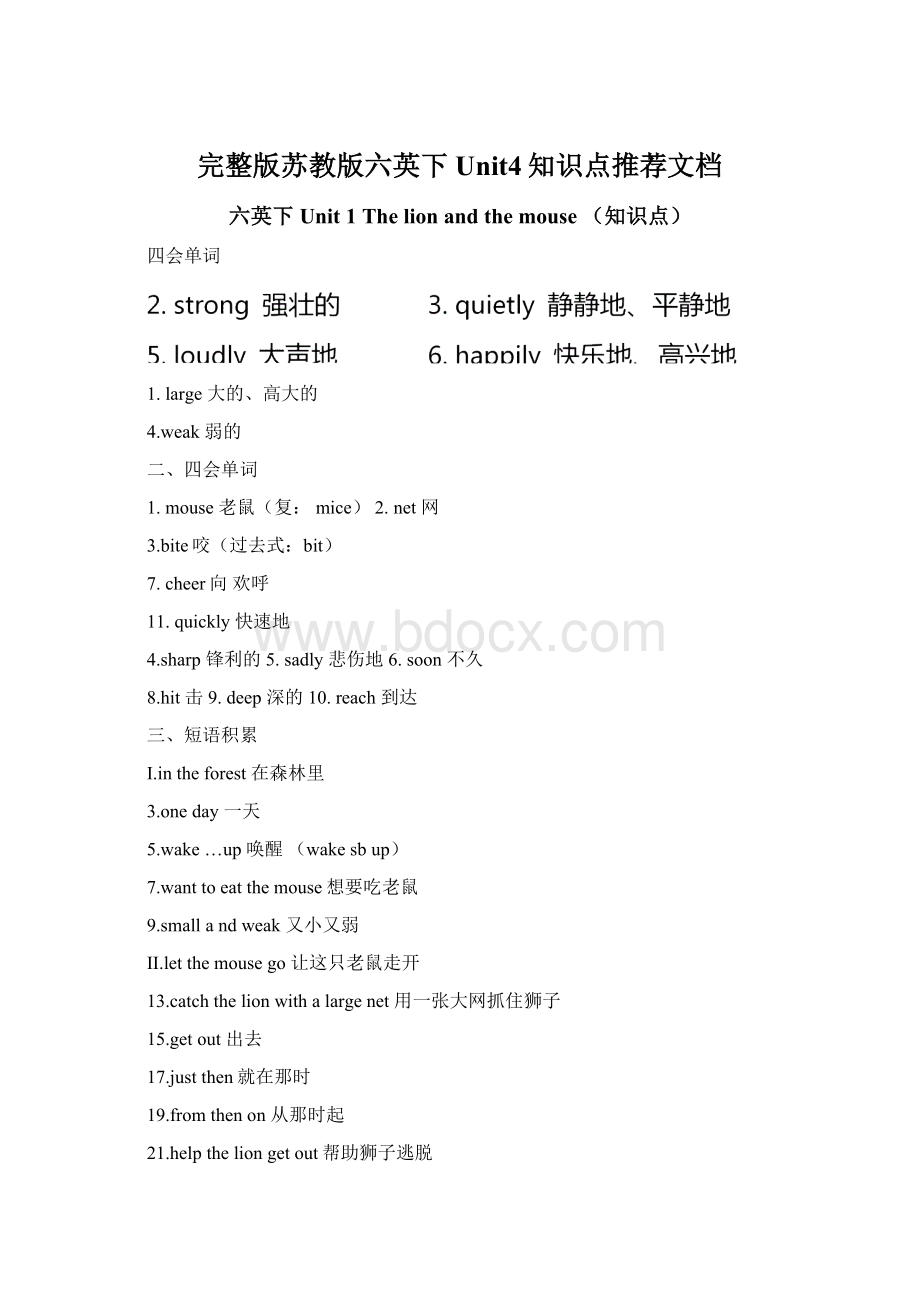完整版苏教版六英下Unit4知识点推荐文档.docx
《完整版苏教版六英下Unit4知识点推荐文档.docx》由会员分享,可在线阅读,更多相关《完整版苏教版六英下Unit4知识点推荐文档.docx(13页珍藏版)》请在冰豆网上搜索。

完整版苏教版六英下Unit4知识点推荐文档
六英下Unit1Thelionandthemouse(知识点)
四会单词
1.large大的、高大的
4.weak弱的
二、四会单词
1.mouse老鼠(复:
mice)2.net网
3.bite咬(过去式:
bit)
7.cheer向欢呼
11.quickly快速地
4.sharp锋利的5.sadly悲伤地6.soon不久
8.hit击9.deep深的10.reach到达
三、短语积累
I.intheforest在森林里
3.oneday一天
5.wake…up唤醒(wakesbup)
7.wanttoeatthemouse想要吃老鼠
9.smallandweak又小又弱
II.letthemousego让这只老鼠走开
13.catchthelionwithalargenet用一张大网抓住狮子
15.getout出去
17.justthen就在那时
19.fromthenon从那时起
21.helptheliongetout帮助狮子逃脱
23.laughloudly大声地笑
25.sayhappily高兴地说
27.ahappyboy一个快乐地男孩
29.Aesop'sFables伊索寓言
31.play...happily玩得很开心
33.cheerforthemloudly大声地为他们喝彩
35.findaholeintheground在地上发现一个洞
38.haveanidea有一个主意(想法)
40.pouritintothehole把它倒进洞
42.helphimup帮他上来
44.becomehappy变得开心
四、语法
一)动词后用副词
walk/write/read+carefullyspeak/laugh+loudlycry/ask+sadly
2.largeandstrong又大又壮
4.walkby路过
6.beangry生气
8.someday某一天
10.letsbdo让某人干某事
12.thenextday第二天
14.bitethenetwithhissharpteeth用它的利牙咬网
16.getoutfromthenet从网中出来
18.makeabigholeinthene在网上做了一个大洞
20.becomefriends变成朋友
22.sayquietly平静地说
24.asksadly伤心地问
26.laughhappily开心地大笑
28.sweetshop甜品店
30.Chineseidiombook汉语成语书
32.begoodattabletennis乒乓打得好
34.hittheballhard用力击球
36.toodeep太深
37.reachit(到达)触碰到它
39.bringsomewaterquickly很快带来一些水
41.pour…into把……倒进
43.gotohim去他那里
45.looksad看起来伤心
say/read/sit+quietly
playfootballhappily开心地踢足球
二)•改句子
1.Themousewokethelionup.
1)一般疑问句:
Didthemousewakethelionup?
肯定回答:
Yes,hedid.否定:
No,hedidn't.
2)否定句:
Themousedidn'wakethelionup.
3)划线提问:
Whowokethelionup?
2.Themencaughtthelionwithalargenet.
划线提问:
Howdidthemencatchthelion?
3.Thelionandthemousebecamegoodfriends.
戈U线提问:
Whatdidthelionandthemousebecome?
4.Thelionwantedtoeatthemouse.
划线提问:
Whatdidthelionwanttodo?
三)不规则动词过去式
原形
过去式
原形
过去式
am/is
was
are
were
can
could
get
got
say
said
tell
told
become
became
go
went
come
came
swim
swam
bring
brought
see
saw
drink
drank
hold
held
take
took
run
ran
have/has
had
fly
flew
do
did
meet
met
lose
lost
find
found
catch
caught
teach
taught
wear
wore
eat
ate
write
wrote
think
thought
make
made
wake
woke
buy
bought
bite
bit
read
read
let
let
Unit2Goodhabits知识点
一、四会单词
1.habit习惯2.never从不
4.finish完成5.tidy干净的,整齐的
二、三会单词
1.bad不好的,坏的
3.slowly慢速的地
三、短语积累
1.goodhabits好习惯
3.16.getupearly起床早
5.brushone'Seth(单数tooth)刷牙
7.put…inorder
把……整理得井井有条
9.beforedinner吃饭前
11.dowell做得好
13.helphisparents帮助他的父母
15.feelsleepy感到困倦
17.lastnight昨夜
19.show…around带领参观
21.singbadly唱得不好
23.walkslowly走得慢
四、四会句型
3.late迟,晚
6.fast快地
2.sleepy困得,困倦的
4.badly差的,不好
2.badhabits坏习惯
4.gotobedlate睡得晚
6.beforebedtime睡觉前
8.finishhis/herhomework
完成他/她的的家庭作业
10.listentohisteachers听他老师的
12.keep-cleanandtidy保持干净整洁
14.doone'hsomeworklate迟做作业
16.knowhim/herwell非常熟悉他/她
18.walkfast走的快
20.runfast跑得快
22.gointo走进
1.Iwalkfastinthestreet.在街上,我走得快。
2.We/Theydowellathome.我们/他们在家表现不错。
3.Hegetsupearlyinthemorning.他早上早早起床。
4.Hegoestoschoolearlyinthemorning他早上早早上学。
5.Shegoestobedlate她上床睡觉迟。
6.Henevergoestobedlate.他从不晚睡。
7.Ialwayshavemymealsontime.我一直准时吃饭。
8.Weusuallyfinishourhomeworkbeforedinner.
我们通常在晚饭前我成我们的家庭作业
9.Theyoftendotheirhomeworkintheevening.他们经常在晚上做他们的家庭作业。
10.Hesometimesfeelssleepyinthemorning.他有时在早上觉得困。
注:
程度的频繁到不频繁:
always总是--usually通常--often经常--sometimes有时-never从不用法:
放在be动词和助动词后面;行为动词前。
一般现在时:
表示经常性的事情,经常性的动作或一般性事实。
时间状语:
often经常,usually通常,always总是,every每个,sometimes有时,at••在几点钟
只有在第三人称单数用动词的“三单变化”,其他用动词的原形。
三单变化:
1.多数在动词后+splay—playslike—likes
(1)直接在动词词尾加-s.
ask---askswork---worksget---getsstay---stays
(2)以字母s,x,ch,sh或o结尾的动词,在词尾直接加-es.
watch---watcheswish---wishesfix---fixesdo---does
go---goespass---passesfinish---finishescatch---catches
(3)以辅音字母加-y”结尾的动词,要先变y为i再加-es.
try---triesstudy---studiescry---criesfly---flies
2.不规则变化:
beisarehavehas
Unit3Ahealthydiet知识点
、单词
healthy健康的
need需要
sausage香肠
diet饮食
porridge粥
cereal
谷物,谷类
cola可乐
western西方的
steamedbuns馒头,小笼包
alittle一点afew几个
atatime一次toomuch太多
、短语积累
I.haveahealthydiet有健康的饮食
3.eatsweets(cakes吃糖(蛋糕)
5.everyday每天
7.have…forbreakfast/lunch/dinner
早饭/午饭/晚饭吃……
9.havesomebread(milkfish,meat)
吃一些面包(牛奶,鱼肉)
II.everyweek每周
13.eatalittlerice吃一点米饭
15.eatalittle吃一点点
17.eatsomefruit吃一些水果
19.getout出去
21.westernpeople西方人
23.drinktoomuchcola喝太多的可乐
25.begoodfor对有好处,对
2.likedoingsth喜欢做某事
4.drinkwater喝水
6.alittlewater一点点水
8.havebreakfast/lunch/dinner
吃早饭/中饭/晚饭
10.haveafeweggs
吃一点鸡蛋
12.havealotofnoodles吃许多面条
14.likesweetfood喜欢甜食
16.atatime一次
18.havealotoffood吃许多食物
20.Chinesepeople中国人
22.takeasmallbottle拿一小瓶
24.havearest休息一下
.有益
二、语法点
1.数量词的用法
many+可数名词复数
much+不可数名词
一些:
some(any)+可数名词复数或不可数名词
许多:
ny用于一般疑问句和否定句
=alotof=lotsof+可数名词复数或不可数名词
ome用于肯定句和表示征求意见的句子
ralittle+不可数名词
—占:
<
八'、•Iafew+可数名词复数
2.名词的用法
名词可分为可数名词和不可数名词:
(1)可数名词有单数、复数之分,如:
mapfmaps
(2)不可数名词没有复数形式,只有单数形式。
如:
waterbreadjuicemeatmilkricefoodfruit
(3)可数名词变复数规则
1.直接在名词末尾加s.女口:
desk-desks
2.以s,x,sh,ch结尾的加es,
女口:
box-boxes,brush-brushes,watch-watchesbus-busesglass-glasses
3.以y结尾,前为辅音字母,要变y为i+es.女口:
baby-babiesfamily----family
factory----factoriescountry----countries
4.以f/fe结尾,要变f为v+es.如:
knife-knivesleaf----leaves
5.以o结尾,外来词或缩写的词,直接加s.女口:
zoo-zoosphoto----photos
但:
tomato----tomatoes,potato----potatoesmango----mangoes
6.不规贝Uman----menwoman----womenfoot----feettooth----teeth
mouse----micechild----children
四、重点句型
We
They
You
eat
clotof
noodles
meat
have
some
vegetables
bread
Unit4Roadsafety知识点
、单词
3.cross穿过,穿行
7.pavement人行道
11.stay保持
4.safely安全地
8.easily容易地
12.light灯
1.roadsafety道路安全
3.inthecity在城市里
5.lookforazebracrossing找一条斑马线
7.waitforthegreenman等待绿灯
9.keepsafe保持安全
11.lookright看右边
13.lookoutforcarsandbikes小心小汽车和自行车
15.seeyoueasily很艮容易看见你
17.achild一个孩子
19.manycarsandbikes许多小汽车和自行车
21.staysafeontheroad在路上保持安全
23.waitforme等我
25.findazebracrossing找到一条斑马线
27.theleftsideoftheroad
马路的左边
2.manybusyroads许多繁忙的道路
4.crosstheroadsafely安全地过马路
6.lookatthetrafficlights看交通灯
8.seetheredman看红灯
10.waitonthepavement在人行道上等待
12.lookleft看左边
14.crosstheroadwithotherpeople
和其他人一起过马路
16.somechildren一些孩子们
18.playontheroad在路上玩
20.followtherules遵守规则
22.waitforthebus等待公交车
24.theotherpeople其他人
26.runquickly快速地跑
28.driveontherightsideoftheroad
在马路的右边驾驶
32.getonthebus上车
34.somanycars如此多的车
36.gofast快点去
38.lookatthegreenlight看绿灯
40.goon继续,继续前进
42.gotoseethedoctor去看医生
44.playballgames玩球类游戏
46.keepyourdeskclean保持桌子干净
47.listentoyourteachersinclass在课堂上听老师讲
三、句型:
1•你如何安全地过马路?
我必须寻找一条斑马线。
A:
Howcanyoucrosstheroadsafely?
B:
Imustlookforazebracrossing.
2.为了安全地过马路你必须做什么?
我必须看交通灯。
A:
Whatmustyoudotocrosstheroadsafely?
B:
Imustlookatthetrafficlights.
3.为马路上你们绝不能做什么?
我们绝不能在路上玩。
A:
Whatmustyounotdoontheroad?
B:
Wemustn'tplayontheroad.
4.你不能在这过马路。
Youcan'tcrosstheroadhere.
5.我能看电视吗?
不,你不能。
现在晚了。
你必须去睡觉。
A:
CanIwatchTV?
B:
No,youcan't.It'slate.Youmustgotobed.
6.我必须去看医生吗?
是的,你一定要去。
你不能去学生因为你生病了。
A:
MustIgotoseethedoctor?
B:
Yes,youmust.Youcan'tgotoschoolbecauseyouaresick.
四、语法知识
1.情态动词can的用法
can有一定的词义,但不能独立存在,它必须与动词原形一起构成谓语。
情态动词can没有人称和数的变化。
其具体用法如下:
(1)表示"能、会",指脑力或体力方面的"能力"。
例如:
JimcanswimbutIcan't吉姆会游泳,但我不会。
(2)表示"可能",常用于否定句或疑问句中,指某种可能性。
例如:
Canhecomeheretoday,please请问他今天能到这里来吗?
(3)表示"可以",常用于口语中,指许可或请求做某事。
例如:
CanIhaveacupoftea,please?
请问我可以喝一杯茶吗?
补充:
1can在口语中可以代替may表示许可或可以。
2can't在口语中代替mustn't时,表示禁止或不准。
例如:
Youcan'tplayfootballinthestreet不准在马路上踢足球。
2.情态动词must的用法
情态动词must没有人称和数的变化,直接加动词原形
(1)表义务,一定要,必须”。
例如:
Youmusttalktothemabouttheirstudy.你必须同他们谈谈关于他们学习的事。
(2)在否定结构中表一定不要,不许。
例如:
Youmustn'tplayontheroad.你一定不要在路上玩。